“To survive post the pandemic, malls in the Middle East need to embrace the digital age. From a business standpoint, malls must reinvent themselves and focus on a curated mix of retail and experiential offerings. From a technology standpoint, it means embedding digital, data, and AI in almost every aspect; making data driven strategic decisions, optimizing operations, proactively managing the future through predictions, and hyper-personalizing its relationship with consumers”
Roland Debbane, Consulting Director ARTEFACT
Context & Market Dynamics
In the wake of the COVID-19 pandemic, the global retail industry has undergone a significant transformation. Despite the tremendous growth of eCommerce, the GCC retail landscape has shown that physical assets and a tangible shopping experience are here to stay. Although malls remain a fundamental component of the retail sector, consumer demands have shifted, bringing challenges but also opportunities for mall owners who can identify them.
On the consumer side, expectations have emerged for greater flexibility, convenience, and catering to daily needs. The pandemic has made consumers more aware of their work-life balance and well-being, which impacts the categories and brands they expect to have readily available to them. Consumers are looking for a combination of shopping for physical goods, services, and experiences.
On the retailer side, these shifts present unique challenges. Certain categories and brands have experienced substantial growth, resulting in intense competition for prime real estate in the region’s premium assets. This has created difficulties for retailers looking to secure space in highly sought-after locations.
As a result, the balance of the tenant/landlord relationship has radically changed from what it was just a few years ago. The selection process has become more favorable to the landlord. This presents mall owners with a unique opportunity to attract brands that are missing from the tenant mix and provide a more even distribution of categories throughout the mall.
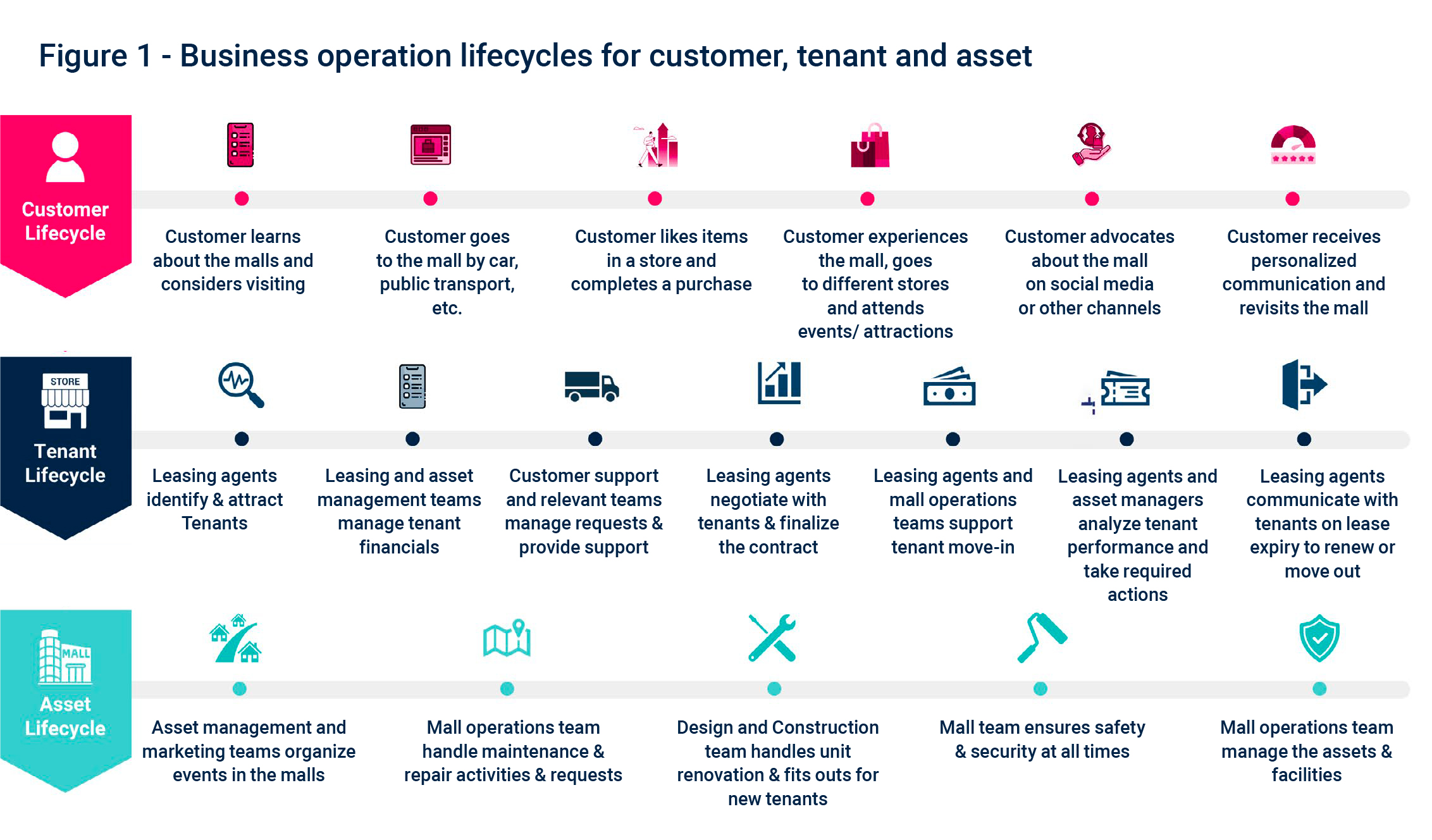
How can data & AI help?
It is important to understand that a mall is a living, breathing organism that requires constant attention and adjustment to remain attractive, on-trend and profitable. Managing retail assets requires a holistic approach to making insight-driven strategic decisions and running efficient and optimized business operations across the three fundamental pillars of asset, tenant and customer.
Data is a critical component of all three pillars of the shopping mall business, serving to connect, measure, maintain and inform both strategy and operations. At Artefact, we recognize the importance of implementing holistic data & AI strategies for mall owners. These strategies enable the identification and realization of the untapped potential and value of data through the application of business-driven data and AI use cases.
This article explores how mall owners can meet consumer demands by implementing holistic data and AI strategies to remain competitive, achieve growth, and improve profitability. By identifying and addressing specific business objectives with data and AI, mall owners can leverage powerful tools to improve tenant mix and mall layouts, proactively manage tenant performance, and optimize marketing ROI. In addition, mall owners can monetize data-driven services, moving beyond traditional rent-based models to service-based models.
How to extract value from data & AI?
Our approach to data & AI in the mall industry is rooted in a business-driven strategy, where we identify specific objectives to extract maximum value from data. To do so, we follow a simple but effective step-by-step approach:
1. We begin by identifying the mall’s overarching strategic goals (e.g. revenue growth, cost reduction, customer experience improvement).
2. We then dive deep into the core business operations, defining the key lifecycles of the mall across three key pillars: asset, tenant, and customer (see Figure 1).
3. We meet with executives, business heads, and operations managers from all relevant departments to detail the step-by-step processes and interdependencies of each business domain.
4. At every step, we root-cause and capture critical business and operational challenges (see Figure 2).
5. We define clear problem statements and business metrics that suffer as a result.
6. Finally, we define and design a data & AI use case to solve them (see Figure 2).
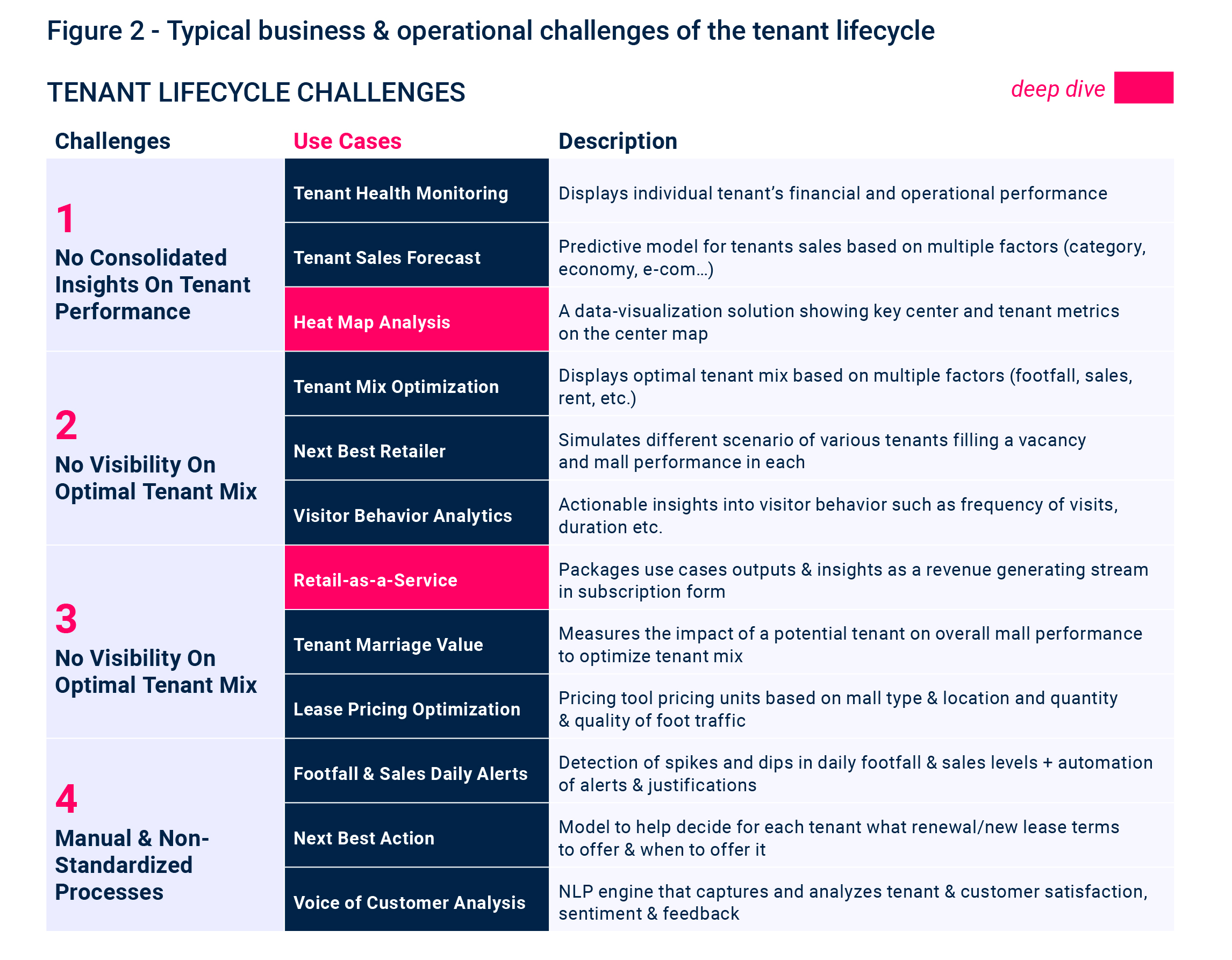
A data & AI use case refers to the practical application of data analysis and artificial intelligence techniques to solve a specific business problem (e.g. decreasing footfall levels in a mall) or to achieve a particular goal (e.g. increasing marketing ROI). It involves leveraging data and AI tools to generate actionable insights and drive informed decision-making in various industries and sectors.
For instance, a powerful tool for mall managers is the ‘Heatmap Analysis’ use case (see Figure 3) that helps in providing visibility on tenant performance, footfall performance, and optimization of mall layout. It is a data-driven solution that involves overlaying different datasets like visitor traffic data and leasing performance data (e.g. occupancy cost ratios, sales density) to reveal business insights. Visitor traffic can include data from Wi-Fi or beacon technology, footfall counters, or cameras to track movement and create a visual representation of their behavior in the form of a heatmap.
This type of analysis allows mall owners to identify high-traffic areas, such as popular stores or attractions, and cross that with low performing zones/tenants that may require attention. By analyzing these patterns, operators can make strategic decisions on store placements, tenant mix, and promotional activities to optimize layouts and improve visitor experience.
Key performance indicators (KPIs) that can be analyzed through a heatmap analysis include foot traffic, customer dwell time, and conversion rates. These insights can help mall owners measure the effectiveness of marketing campaigns, identify customer behavior trends, and optimize staffing and resource allocation.
By leveraging heatmap analysis, mall owners can gain valuable business benefits and actionable insights such as improving store layout and placements, optimizing staff allocation, and identifying areas for improvement in marketing campaigns. Ultimately, this can lead to increased customer satisfaction, higher conversion rates, and improved mall profitability.
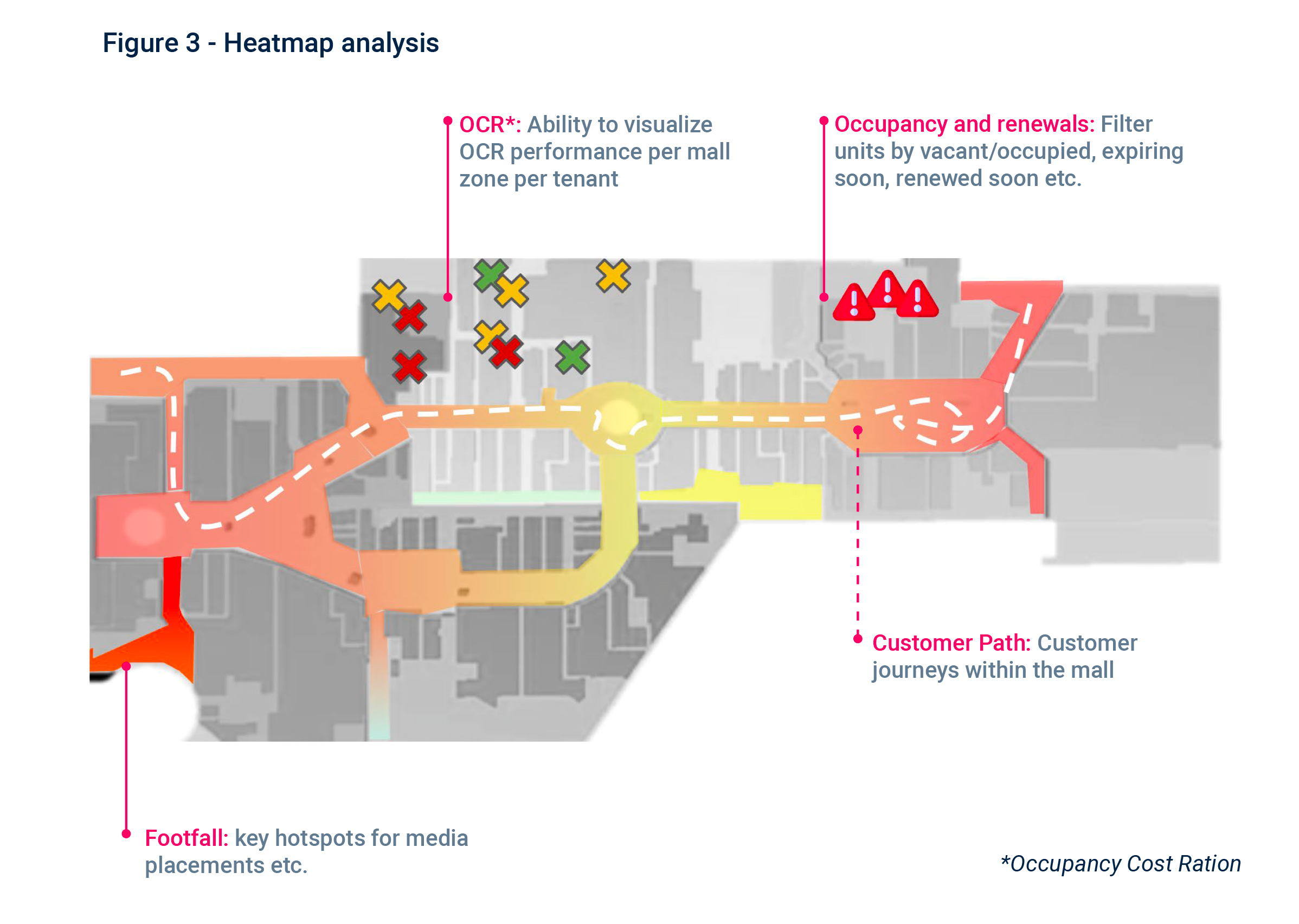
Furthermore, mall owners are discovering the potential of transforming data and insights into a revenue-generating asset. By deploying data and AI use cases at scale, such as heatmap analysis, tenant performance analytics, and visitor audience activation, mall owners can create new opportunities to monetize their data and move beyond traditional rent-based models towards a service-based model. This approach involves packaging data-driven services and selling them to retailers and other stakeholders within the mall ecosystem through innovative leasing models. This approach creates a unique value proposition for mall owners and fosters new streams of revenue, resulting in enhanced profitability and growth.
Retail-as-a-Service (see Figure 4) is a new model that’s disrupting the retail shopping mall industry. A modern service-based, performance-driven contract model, it allows retailers to subscribe to a range of operational service-packs through a monthly subscription fee.
There are typically three levels of subscriptions offered: Basic, Basic+, and Premium:
Retailers can also choose to mix and match additional operational service-packs, including logistics pack, retail/ experiential pack, and facilities/property management pack.

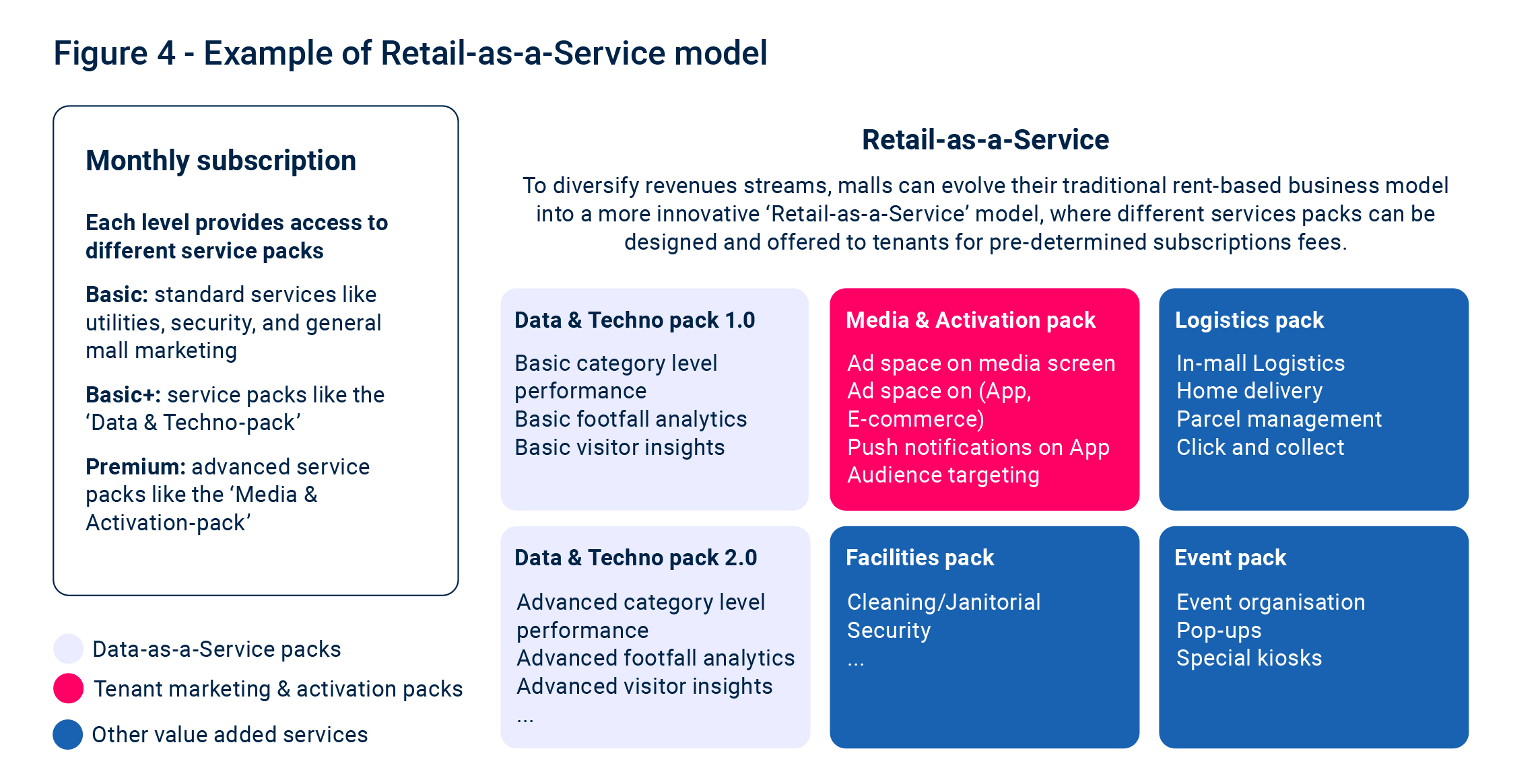
Zoom-in on the ‘Media & Activation-pack’
In-mall retailers often struggle to efficiently allocate the marketing budgets included in their lease agreements with the mall. One of the main challenges retailers face is the lack of synchronization between mall owners and retailer marketing teams. In addition, each shopping center has its own unique approach to managing and implementing marketing strategies, making it difficult for retailers to effectively promote their stores through the shopping center’s marketing channels.
The solution is to build a custom digital media and activation platform (see Figure 5) that leverages the power of data and AI models. By deploying an AI-powered media and activation platform, retailers can standardize, automate, manage and track their marketing and promotional efforts across multiple locations, ensuring consistency across all stores. The platform would include advertising credits that can be used to activate directly to visitors. Ads can be placed on media screens, local ad networks and mall-owned digital assets such as web, app, CRM and loyalty. Audience targeting options are also available for demographics, non-customers and lapsed customers.
This innovative platform enables retailers to fully leverage their shopping center’s marketing channels to drive traffic and sales while saving significant amounts of time, money and resources. With the ability to efficiently execute mall marketing campaigns and optimize every opportunity to reach customers, retailers can attract more foot traffic to their stores and boost sales. Overall, implementing AI-powered marketing solutions can help retailers maximize their potential and achieve greater success in their marketing efforts.
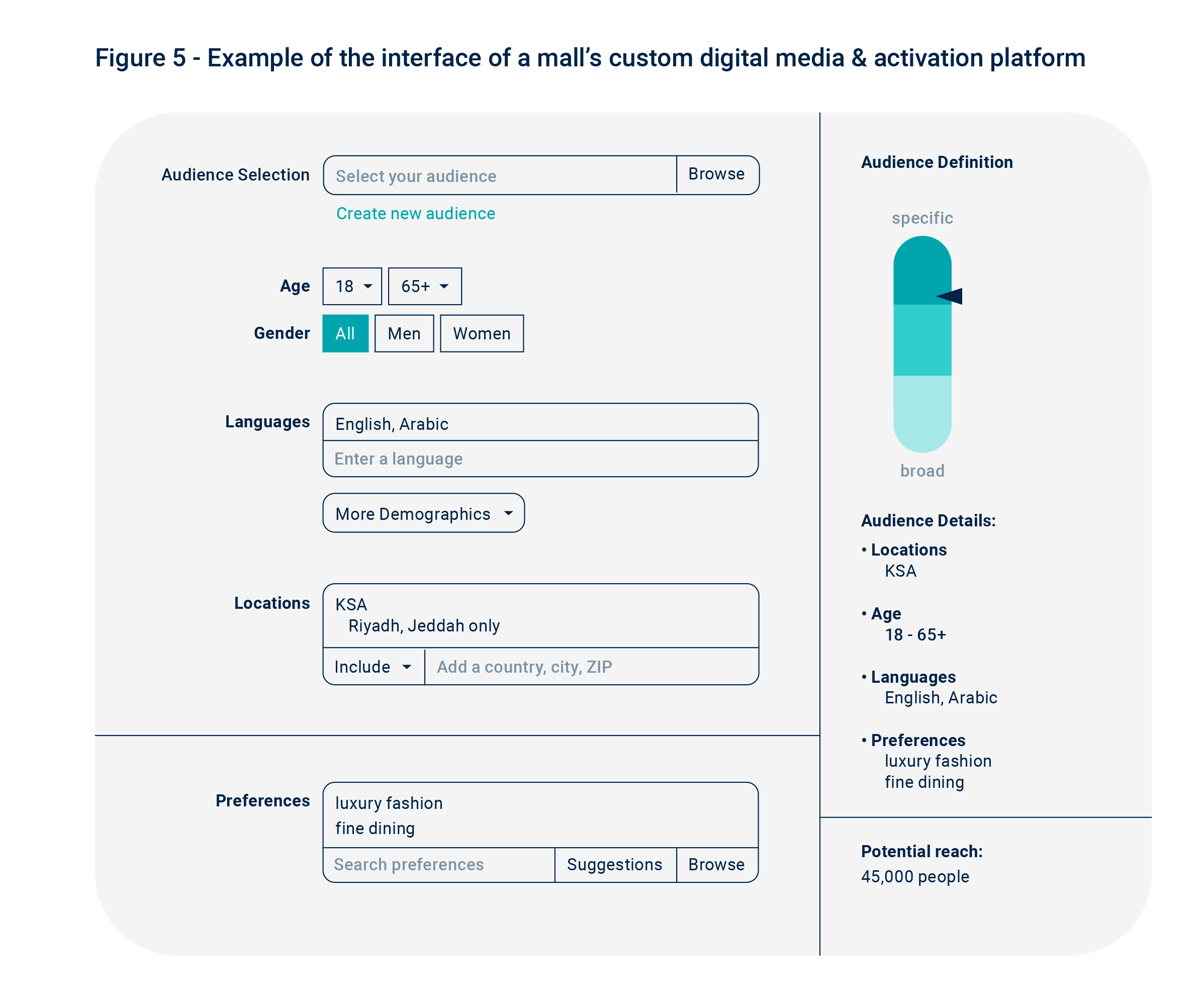
Closing note
As the retail industry recovers and evolves in the wake of the COVID-19 pandemic, malls remain a cornerstone of this landscape for the long term. However, new consumer expectations demand new experiences beyond the traditional brick-and-mortar retail model. Consumers are looking for a combination of shopping for physical goods, services and experiences. To meet this demand, mall owners must embrace digital, data, and AI technologies and implement robust business-driven strategies to unlock value. Whether it’s understanding visitor demographics and affinities, proactively managing tenant performance, understanding the root causes of asset performance and returns, or generating new revenue streams through data monetization, using digital, data, and AI is a differentiator that would put mall owners ahead of their competition.

 BLOG
BLOG




